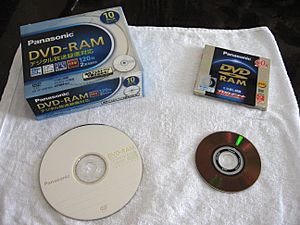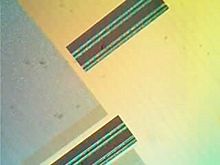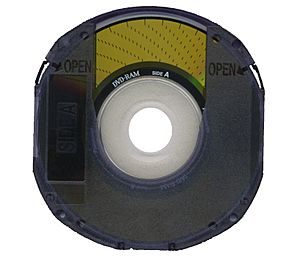DVD-RAM facts for kids
DVD-RAM (which stands for DVD Random Access Memory) is a special type of DVD disc. It was created in 1996 by a group called the DVD Forum. Unlike regular DVDs that you just watch, DVD-RAM discs are designed to be rewritten many, many times. You could use them in computers, camcorders, and even personal video recorders starting in 1998.
For a long time, Panasonic was the only company still making these discs. But in May 2019, they announced they would stop. This was because fewer people were buying them. Panasonic made these discs under their own name and also for the Verbatim brand.
Contents
How DVD-RAM Works
DVD-RAM discs use a cool trick called "phase change technology." This is different from older methods that used magnets. Phase change technology uses a laser light to heat up a special material on the disc. When heated, this material can change its state, like ice turning into water and back again.
- When the laser heats the material quickly and lets it cool fast, it becomes "amorphous" (like glass).
- When the laser heats it and lets it cool slowly, it becomes "crystalline" (like a crystal).
These two states reflect light differently. A laser can then read these differences to know if it's a "1" or a "0" of data. This is how information is stored and read on the disc.
Tracks and Sectors
Most DVDs and CDs have one long spiral track for data. But DVD-RAM is different! It uses many circular tracks, like the rings on a tree. Each of these tracks is divided into small, pre-made sections called "sectors."
This design makes DVD-RAM discs work a lot like hard drives or floppy disks. Because of this, your computer's OS can usually use DVD-RAM discs directly. You don't need special software to save files on them. A 12 cm disc, which holds 4.7 GB, has 35 different zones of tracks. Each zone has more sectors as you move closer to the outside of the disc.
DVD-RAM Versions
The companies that made DVD-RAM discs formed a group called the RAM Promotion Group (RAMPRG). This group included big names like Hitachi, Toshiba, Panasonic, and Samsung. They helped set the standards for DVD-RAM.
Over time, different versions of DVD-RAM were released:
- Version 1.0 (1997): These discs could record at 1x speed. They held 2.58 GB on each side.
- Version 2.0 (1999): These were faster at 2x speed. They held the more common size of 4.7 GB per side.
- Version 2.1 (2000): This version introduced smaller 8-cm discs. These held 1.46 GB per side.
- Version 2.2 (2004): This version divided discs and drives into two classes (Class 0 and Class 1) because they weren't always compatible. Class 1 discs, called DVD-RAM2, could record much faster.
Even smaller 80 mm DVD-RAM discs existed. They could hold 1.46 GB for a single-sided disc or 2.8 GB for a double-sided disc. However, these were not very common.
Originally, DVD-RAM discs often came inside a protective cartridge. Newer DVD recorders can usually use the discs with or without the cartridge. You can often take the disc out of the cartridge to use it in different drives.
Compatibility with Computers
Many computer operating systems can use DVD-RAM discs easily. This includes classic Mac OS (from version 8.6), macOS, Linux, and Microsoft Windows XP. Older versions of Windows might need special software to work with them.
- Windows XP can write directly to DVD-RAM discs that are formatted with FAT32. For other formats, you might need extra software.
- Windows Vista and newer versions of Windows can easily read and write to both FAT32 and UDF formatted DVD-RAM discs.
- Older classic Mac OS versions could read and write many types of formatted DVD-RAM discs. Newer Mac OS X versions changed how they handled these discs, but later brought back support for some formats.
Some high-end computers, like IBM System p mainframes, actually needed DVD-RAM discs instead of other types of rewritable DVDs. Even the Nintendo Wii U game console could use DVD-RAM for extra storage!
Advantages of DVD-RAM

DVD-RAM discs had some great features:
- Long Life: They are very durable. Data on them can last for about 30 years if the disc isn't physically damaged. This made them good for storing important information for a long time.
- Many Rewrites: The slowest DVD-RAM discs could be rewritten over 100,000 times! Other rewritable DVDs (like DVD±RW) could only be rewritten about 1,000 times. Even faster DVD-RAMs could be rewritten 10,000 to 100,000 times.
- Reliable Writing: The drives themselves checked the data as it was being written. This meant you didn't need extra software to make sure your data was saved correctly.
- Data Protection: They had special features to help protect your data from errors.
- Easy to Use: You often didn't need special DVD-burning software. You could use them like a regular removable hard drive, just dragging and dropping files.
- Fast Access: It was very quick to find and open small files on the disc.
- Efficient Storage: They wasted less space when saving small files because of their small block size.
- No Finalization: You didn't need to "finalize" the disc after recording, which was a step required for some other DVD types.
- Time Slip Recording: Some video recorders using DVD-RAM could record one TV show while you watched another, or even watch the beginning of a show while it was still recording!
- More Storage: Double-sided DVD-RAM discs could hold 9.4 GB of data. This was more than dual-layer DVD+RW or DVD-RW discs, which held 8.5 GB.
- Write Protection: If used in a cartridge, they often had tabs to prevent you from accidentally deleting data.
Disadvantages of DVD-RAM
Even with all their advantages, DVD-RAM discs had some downsides:
- Hard to Find Fast Discs: Only 3x and 5x speed discs were easy to buy. The super-fast 12x RAM2 discs were very rare and mostly sold only in Japan.
- Higher Cost: The discs themselves were usually more expensive than other types of rewritable DVDs.
- Less Compatible: Many standard DVD players and recorders couldn't play DVD-RAM discs. This was a big problem, even though DVD-RAM came out before DVD+RW and DVD-RW.
- Slower Random Writes: If you were saving many small files in different places on the disc, it could be slow. The drive had to constantly adjust its speed as it moved around the disc.
See also
 In Spanish: DVD-RAM para niños
In Spanish: DVD-RAM para niños
- Chase Play
- MultiLevel Recording
- Phase-change Dual
- List of optical disc manufacturers
- Live File System






